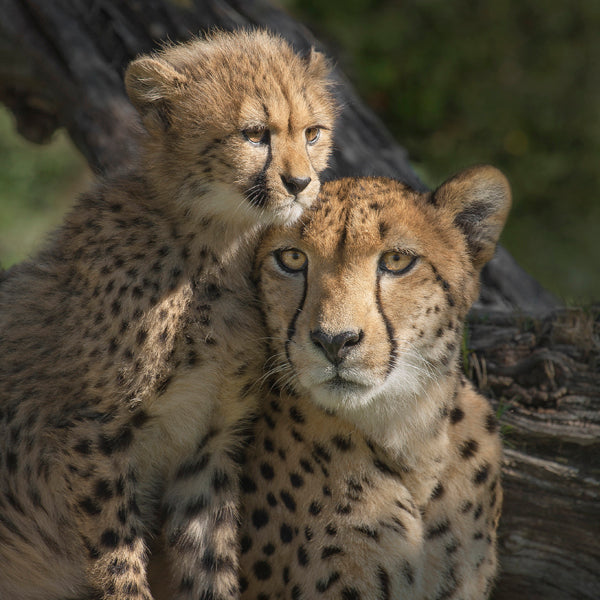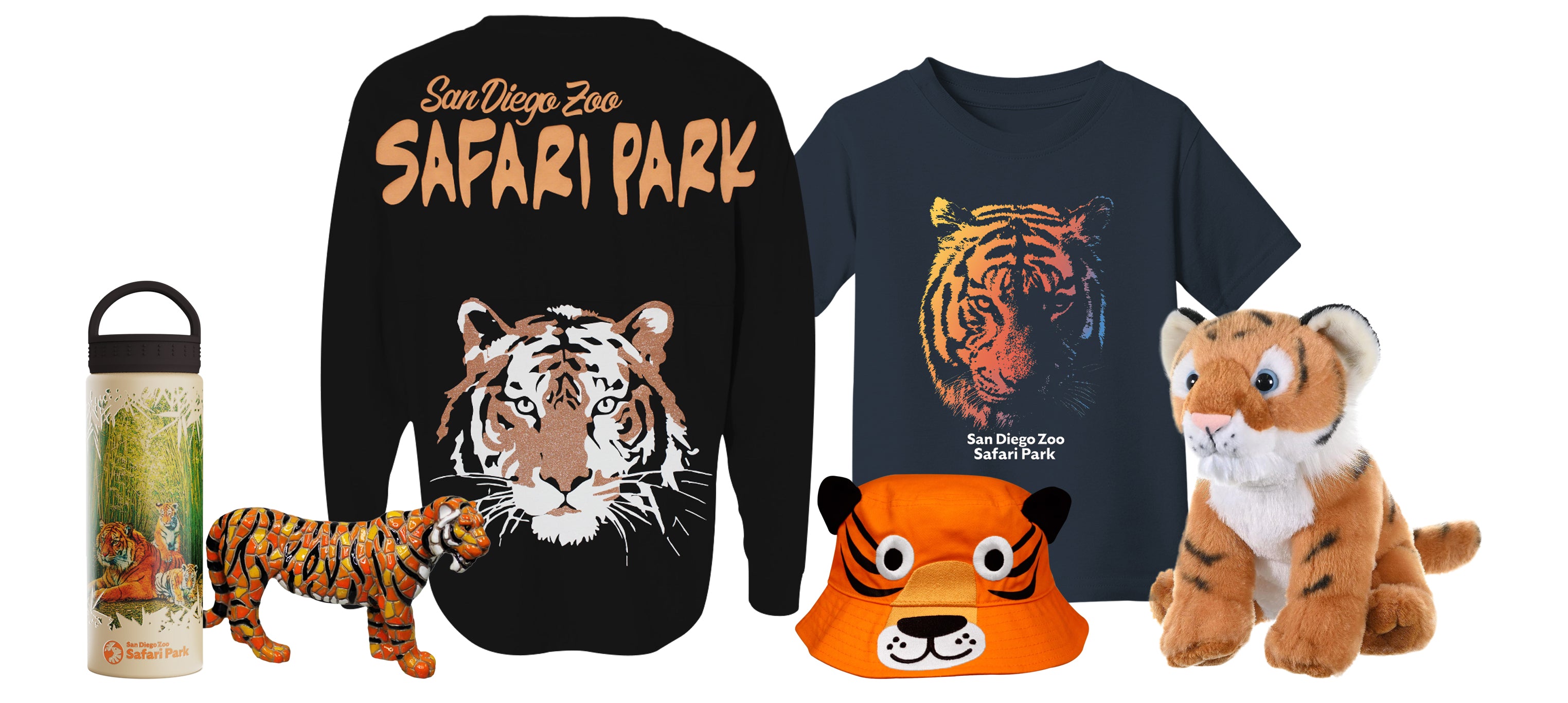Shop All
ADULTS
KIDS
TOYS & BOOKS
FOR THE HOME
ADULTS
KIDS
TOYS & BOOKS
FOR THE HOME
ICONIC & ECO-FRIENDLY
Wildlife
Deals
Two Steps Forward
February 17, 2024 4 min read

For Sumatran Tigers
By Kristi Burtis, D.M., Vice President of Wildlife Care at the San Diego Zoo Safari Park*
In July 2023, just weeks before International Tiger Day, the San Diego Zoo Safari Park (and parents Diana and Dumai) welcomed two Sumatran tiger cubs. The cubs—a male and female—were born on July 12, and we were well aware of the significance of their arrival, as it had been seven years since the Safari Park’s last tiger cub birth. This was a joyous outcome for a collaborative project that paired our team of carnivore specialists with the Association of Zoos and Aquariums (AZA) Species Survival Program (SSP), to support the propagation of this incredible species. The current SSP population consists of 67 animals (30 males, 37 females) in managed care at 28 AZA facilities. The process—and logisitics—of wildlife conservation are governed by strict protocols, but there are still facets that can defy predictability.
Mammalian Matchmaking—and Maternity
SSPs don’t just involve introducing male and female animals; they have to be the right male and female. Several recommended pairings were not successful. Then in March 2023, the wildlife care team at the Safari Park’s Tull Family Tiger Trail habitat welcomed Dumai, an 11-year-old male Sumatran tiger from another facility, where he successfully sired two cubs. Dumai’s demeanor has been described as calm and accepting, and Diana showed immediate interest. Estrus lasts between two and five days, and behavior was monitored by wildlife care specialists to determine if the introduction between Diana and Dumai was safe. At nearly 10 years of age and with multiple attempts to breed, Diana had never conceived. This was her last breeding recommendation by the SSP. After a week of courtship and successful introductions, the wildlife care specialists began to see changes in her body condition, as well as nesting behavior.
Diana started showing signs of labor around 9 a.m. on July 12. She was grooming and having contractions until about 10:45 a.m., when her first cub, an approximately 2.5-pound female, was delivered. Diana seemed startled at first, until her instincts kicked in, and she started cleaning the cub and immediately showing attentiveness to her first offspring. At 1:13 p.m., her second cub—a male weighing 2.5 to 3 pounds—was born after a short delay of contractions and pushing. Once her cubs were cleaned, Diana had a well-deserved rest. Shortly thereafter, the cubs began to nurse. Diana rested most of the afternoon into the evening; the next day, she began taking her cubs to new parts of the nesting area and spending quality time together.
Family Dynamics
The wildlife care specialists were thrilled to watch the cubs thrive. At her first official weigh-in on July 20, the female had grown to 4 pounds. By late October, she was tipping the scale at 25 pounds. The male’s first official weight was 4.25 pounds, and he reached 24 pounds by late October. While both cubs measured approximately 26–27 inches (plus tail) on that day, there are differences in their appearance. The female has darker shoulders and very thick stripes that go across the crown of her head. She tends to be more confident and curious about her environment, and has been observed to be more independent. The male cub is identified by two thick triangles on top of his head pointing toward his tail. His coat also sports a diamond pattern made of stripes on the right side of his neck, just above the shoulder area. He tends to be more of an observer in his environment and will often choose to stay closer to Diana. Both cubs are becoming very mobile and active, and are even starting to become more playful with each other.
We could not engage in the important work that we do if it were not for our generous donors—even when choosing names for our newest arrivals. We are thrilled to share that our donors have carefully selected names that share the complex story of the Sumatran tiger and their plight. The female has been dubbed Puteri, which means “princess” in Malay, and represents the majesty of the species and the significance of this female’s potential to further it. Her brother has been named Hutan, which translates to “forest” in Malay. His name creates an opportunity to discuss deforestation and challenges to human-wildlife coexistence. For example, the Sekalak village in southern Sumatra lies in one of the last remaining strongholds of the Sumatran tiger. The locals revere the Sumatran tiger as both an ancestral spirit and the guardian of the forest.
Safeguarding the Future
Species sustainability efforts are just one aspect of the many important roles zoos play in conservation. The population of Sumatran tigers in managed care has increased on average over the past five years by 1.4 percent annually. The species is categorized as Critically Endangered on the International Union for Conservation of Nature (IUCN) Red List due to the small and fragmented native populations. Tigers face many challenges, including habitat loss and fragmentation, challenges to human-tiger coexistence, and the illegal wildlife trade. Population estimates range from 350 to 600 tigers in 6 major protected areas to possibly 300 or fewer.
Every Sumatran tiger birth is critical to their conservation status in the wild. As an accredited AZA institution, the Safari Park is thrilled to play a role in the effort to combat the worldwide threat to tiger conservation. We are collaborating with local scientists to conserve the region’s unique wildlife, and we work with partners to support efforts to advocate for sustainable palm oil and measures that protect wildlife from illegal trafficking.
Puteri and Hutan represent the hope we have for the future of their species. We are so excited to share these two critically important births, and demonstrate how our Alliance members and guests contribute to the protection and preservation of the Sumatran tiger.
You can make a big impact for these growing cubs with your tiger purchases including t-shirts, hats, and more. As captivating as a tiger’s gaze, you will love our newest San Diego Zoo Safari Park Tiger Spirit Jersey, apparel, and accessories. Tiger cub and big cat plush purchases support future generations of these majestic mammals. Want to see more stripes? Shop our tiger collection here to aid conservation efforts for critically endangered Sumatran tigers.
*As seen in the January/February 2024 issue of The Journal.
Leave a comment
Comments will be approved before showing up.
Newsletter
Find out about our newest arrivals and get special offers in your inbox!

Be a Wildlife Ally
Discover a wild array of products at ShopZoo, where every purchase helps save, protect, and care for wildlife.
Find out about our newest arrivals and get special offers in your inbox!

